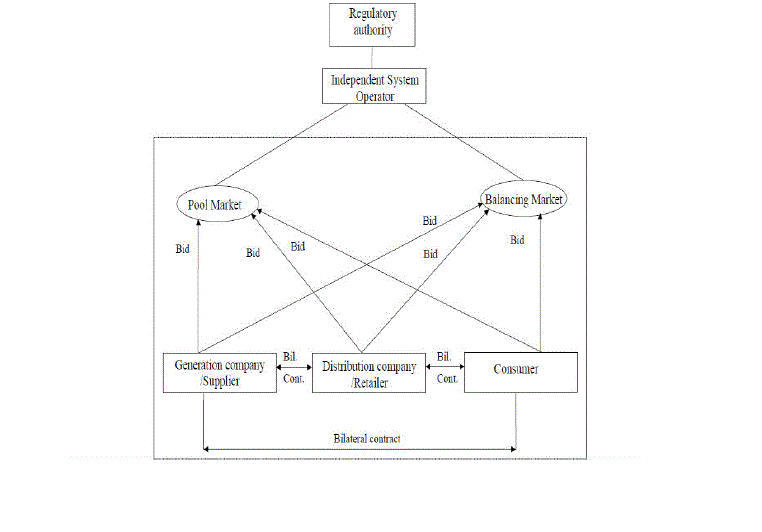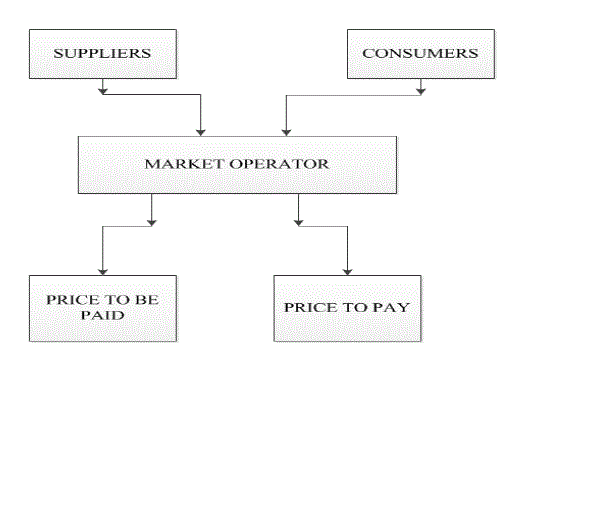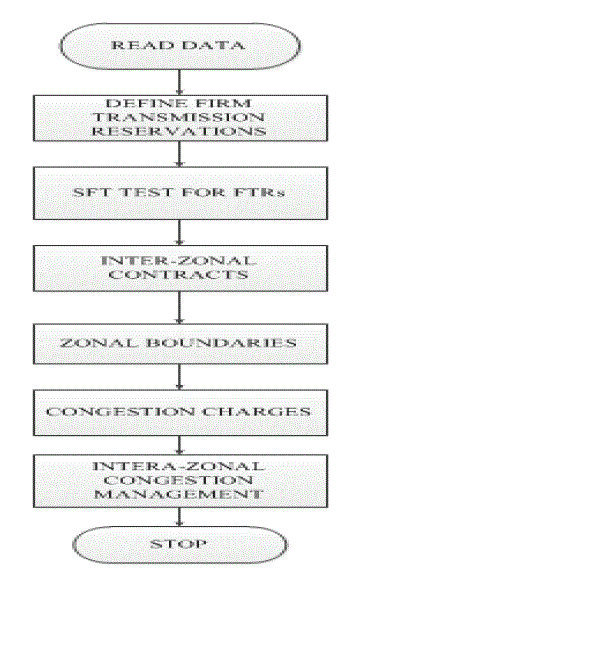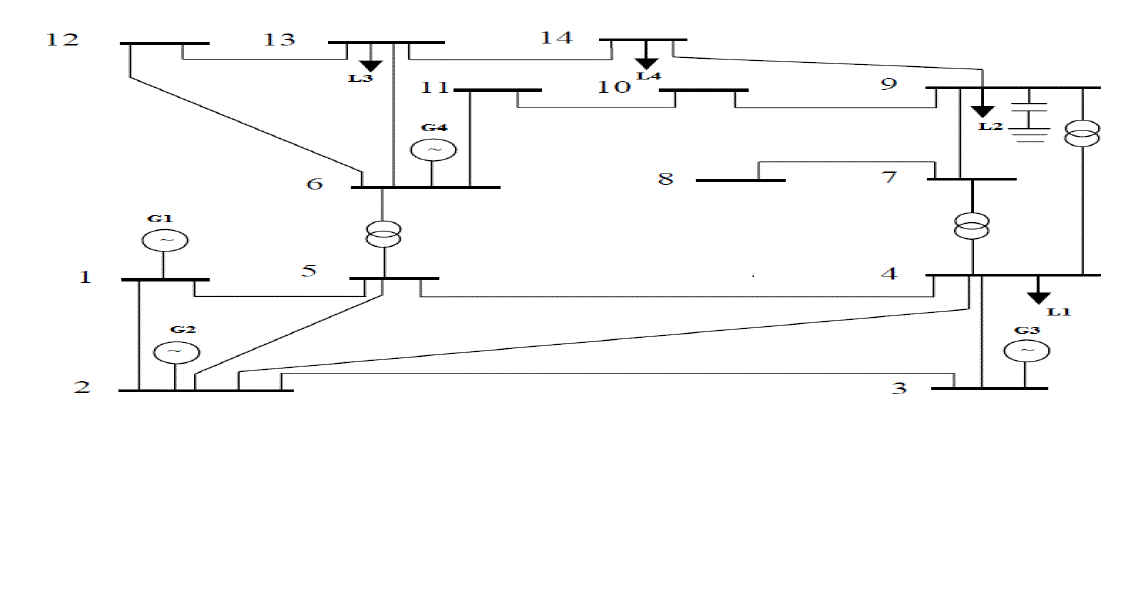Keywords
|
| Deregulated market, Zonal congestion management. |
INTRODUCTION
|
| In the deregulated power market the generation, distribution and transmission are the responsibilities of the different companies i.e. unbundling of the services occur. Discrimination is an important principle of the deregulated market. The main aim of the deregulated power system is to schedule more generation from cheapest available sources with the objective of the minimum production cost. This scheduling is done by the system operator. The deregulated market structure is shown in figure-1[2]. |
| In previous papers, a new zonal/cluster-based congestion management approach has been proposed. The zones have been determined based on lines real and reactive power flow sensitivity indexes also called as real and reactive transmission congestion distribution factors [9]. The paper [4] reviews the CM schemes and the associated pricing mechanism used by the IGOs in five representative schemes. Some more work is also done on finding the transmission congestion cost. Transmission congestion cost is also calculated by using nodal pricing framework [5]. Managing transmission congestion in an unbundled electric power system poses a challenge to an independent system operator (ISO) [8]. There is a previous paper that considers an open transmission dispatch environment in which pool and bilateral/multilateral dispatches coexist and proceed to develop a congestion management strategy for this scenario [8]. In that paper prioritization of electricity transactions and related curtailment strategies are explored and a mechanism for coordination between market participants to achieve additional economic advantages is described In this paper we will re-dispatch the generation and loads for inter-zonal congestion management. Here we will do the Inter-Zonal congestion management. |
DEREGULATED MARKET AND FTR
|
| One of the types of deregulated power market is pool market. In the pool market there is no direct trading of power between consumers and suppliers i.e. there is no direct contact between the producer and consumer. The power is traded through the market operator. The market operator is known Independent System Operator (ISO). The consumer and supplier both submit their bids to the market operator. The ISO minimize the generation cost or active power losses. This objective can be achieved by performing optimal power flow program (OPF). This OPF program take in consideration the transmission line limits. It also minimizes the total cost for the social welfare. According to the OPF program, at these prices at the power is supplied/purchased to consumers/suppliers for the corresponding amount of power. Electricity pool market is shown in the Figure 2[2]. |
| Another type of deregulated power market is known as bilateral market. In the bilateral market, producers and consumer directly negotiate the price of trading energy [3]. Also the quantity of the traded energy is directly negotiated. The schedules of generator are submitted to the ISO. Then the transaction occurs only when the transmission line constraints are not violated [4]. So ISO will accept the schedules only when transaction does not cause any congestion. Practically, not all buyers have contract with the sellers and vice-versa. Mathematically, every bilateral transaction between a seller at bus-m and power purchaser at bus-n satisfies the power balance relationship i.e. PGm-PDn=0 [2]. |
| Besides of these two types of the power market there is another type of market i.e. hybrid market. In this type of the power market the seller may inject power at the several nodes and the buyers also draw load at the several nodes. |
| In the power market to hedge the risk, the participant can purchase a right to transfer power over a constrained transmission path for a fixed price, which is called firm transmission right (FTR).FTRs act as the financial instrument to hedge the risk associated with transmission congestion charges. |
| The marginal cost of supplying the next increment of electric energy at a specific bus considering the generation marginal cost and the physical aspects of transmission system is known as locational marginal cost (LMP) [1]. In the case of the unconstrained optimization problem or if line flow limits are very large, LMPs are same for all the buses. In this case, there is no congestion charge on transmission line. But in case of the constrained transmission line, the difference in the LMPs appears. In simple words, LMP can be defined as the additional cost for providing the one additional MW at a certain load. |
| The buyers and the sellers will experience the actual cost of delivering the energy to locations on the transmission system using LMP. LMP at any node in the system is defined as the summation of the generation marginal cost, congestion cost, and cost of marginal losses. In the case if market participant does not hold FTR and its contract is not |
| curtailable, then the participant will incur a congestion charge. In this case there will be no mechanism to offset the congestion charge. But in the reverse case of above, FTR holder will receive a credit that counteracts the congestion charge for the specified path. FTR credit is given by the product of the amount of FTR and the difference between the LMPs at the beginning and ending point of the FTR. |
OPTIMAL POWER FLOW
|
| The OPF is basically used to optimally dispatch the generation in an area or group of areas. During dispatching the transmission line limits are always take in consideration [5]. The LMP values at all the buses in the power system are calculated considering the transmission line limits. The OPF have to serve the two purposes in the deregulated market. First, it aims to minimize the transacted power cost. Another objective is to cover as much load demand as possible. Social welfare is the objective of the OPF because it aims to minimize the global system costs and thereby to maximize the profit of all the market participants [10]. There is some restriction on the OPF with respect to the line flow constraints, the active and reactive power balance at each system node, the voltage magnitude limits and the active and reactive power generation limits. |
| The optimization can be done either by a linear programming or a quadratic programming. The advantage of these methods is the clear and systematic treatment of constraints [2]. The linear programming has performed a quite efficient operation concerning the active power dispatch. The disadvantage of this method is that when linear programming is used in order to minimize the power losses there is no high acriby by the calculation of optimum. Additionally, disadvantage of the linear programming is very slow convergence rate when the generation cost functions are similar or identical. The second method is based either on Newton algorithm or on a quadratic programming when the Lagrangian of the OPF is quadratic. This method has a great benefit of solving the OPF in a global way. This fact makes them attractive because they are able to calculate exact the optimum. The convergence rate in the Newton approach is also very satisfactory. The major drawback is the handling of the inequality constraints and particularly by the determination of the binding inequality constraints. |
ZONAL CONGESTION MANAGEMENT
|
| In the zonal congestion management, firm transmission reservations are defined. The firm transmission service is reserved and scheduled between the specified point s of receipt and delivery. All the loads are served by the generations in the reservation process. FTRs are allocated to the consumers according to their annual peak load [6]. Different FTRs are then modeled as the generations at the points of injections (as loads at the point of withdrawn). Simultaneous feasibility test (SFT) will be then performed to check out the FTRs feasibility. For the congestion management then we will make inter-zonal contracts. After the determination of the LMPs at the each node then we determine the zonal boundaries. Then calculate the ALMP in each node. On the basis of these ALMP we will calculate the congestion charges based on actual deliveries to different loads according to the re-dispatch solution. Then we make the intra-zonal congestion management. Flow chart for zonal congestion management is shown in Fig 3. |
| Different zones are made in a system. These zones are made on the basis of the LMPs. LMP of near-by values are considered as zone-1 and other zone has its LMP values different from zone-1 LMPs. |
| The firm transmission service is reserved and scheduled between specified points of receipt and delivery. On the basis of the available transfer capability reservation is done. Firm transmission reservation can be of two type long term and short term reservations. In the long term reservation the duration of the reservation is about one year or more. But, in the short term reservation the duration of the reservation is less than one year. |
| Designated network resource to the designated network customer load is the path for the network customers. |
| The feasibility test of the FTR is passed only when the inter-zonal line flows are less than that of the thermal limits. When the FTRs are not feasible as given by the SFT, then the FTRs will be reduced in proportion to their MW values until SFT gives a feasible solution. |
NUMERICAL PROBLEM AND RESULT
|
| In this paper we will consider a 14bus system with its line parameters given in Table I and contracted generators are shown in Table II. The contracted generators are used to fulfil the annual peak load demand. Contracted generation should be in balance with the annual peak load demand. But, in some cases it is not true. The contracted generation is not in balance with peak load demand. 14-bus system is shown in the figure 4.14-bus system is divided in to the different zones on the basis of the LMPs. If the contracted units generates surplus in the generation then there will be interchange of energy with the energy spot market. Generation or load LMP is assumed to be same as that of the ALMP. Here in this example we assume some assumptions like system is lossless and firm transmission reservation is assumed to be equal to that of the peak load. |
| Table-3 shows the data for the generation and load at a certain hour. This table represents the preferred generation and load bids at any certain time. These schedules are submitted to the ISO. ISO will check out whether these schedules cause any congestion in the system. In case of the congestion the schedules are adjusted by the ISO. If the generation of generator is more than preferred schedules than the surplus will be sold to the spot market. |
| But if any generator is generating less than the preferred schedules, the shortage will be supplies by the spot market. Table-2 where the generation at each bus is equal to the sum of contracted generations at that bus to serve different loads. For example- G3 is serving two loads L1 and L3. L1= 50 MW and L3=45MW is served by generator G3. So, total generation by the generator G3 is 95MW. |
| All the FTRs are modeled as generators at the point of injection and it is modeled as the load at the point of the withdrawal. After representing these FTRs we run the dc load flow. If the line flow in each inter-zonal lines is below the thermal limit than the FTRs SFT test will be guaranteed. Note that in SFT, the total generation should be equal to total load.Table-4 shows the data of the generators and loads for SFT. |
| The SFT results are given in the Table-5. The result shows that FTRs are feasible and there is no inter-zonal line carrying power above the thermal limits. Since there is no congestion in the line so the schedules will be accepted by the ISO. But in the case of congestion the ISO will not permit the market participant for the transaction of power. Hence the schedules will be rejected in case of congestion. |
| The above results show that FTRs are feasible and no inter-zonal line is carrying power above its thermal limit. The inter-zonal lines are defined initially based on a similar situation. Initially, we consider lines 1–2, 1–5 and 9–10 to be most frequently congested (inter-zonal lines). |
| Table 6 shows the line flows indicating that all inter-zonal line flows are within limits. It means that generation units with the adjustment ranges given in Table 3 are capable of alleviating congestion on intra-zonal lines. The results also show that no intra-zonal line is overloaded. So no further intra-zonal-management will be performed [1]. Table 7 shows that the preferred generations and loads are re-dispatched to remove inter-zonal line flow violations. The results obtained in Table 7 will be used for the calculation of congestion charges because the re-dispatched values represent actual generations and deliveries during this hour. |
CONCLUSION
|
| The LMPs of the system can be calculated from the inter-zonal congestion management optimization problem. Buses having closed LMP values are considered in one zone. This observation confirms the assumption that the most frequently congested lines divide the system into different zones. Each zone contains buses with nearly same LMPs, and the lines connected to these zones are inter-zonal lines. After that we can take decision to confirm the initial assumption of zonal boundaries to combine or split the zones to form new zones. |
Tables at a glance
|
 |
 |
 |
 |
| Table 1 |
Table 2 |
Table 3 |
Table 4 |
|
|
|
Figures at a glance
|
 |
 |
 |
 |
| Figure 1 |
Figure 2 |
Figure 3 |
Figure 4 |
|
| |
References
|
- Mohammad Shahidehpour, Hatim Yamin, Zuyi Li “Market Operations in Electric Power Systems: Forecasting, Scheduling, and risk management”Wiley-IEEE Press; 1st edition,March 2008.
- Georgios Stamtsis “Power transmission cost calculation in deregulated electricity market”
- Ashwani KUMAR, Charan SEKHAR ‘Demand response based congestion management in a mix of pool and bilateral electricity market model” HigherEducation Press and Springer-Verlag Berlin Heidelberg 2012
- Bompard E, Correia P, Gross G, Amelin M. Congestion management schemes: A comparative analysis under a unified framework. IEEE Transactionson Power Systems, 2003, 18(1): 346–352.
- Singh H, Hao S, Papalexopoulos A. Transmission congestion management in competitive markets. IEEE Transactions on Power Systems, 1998, 13(2):672–680.
- Alomoush M I, Shahidehpour S M. Fixed transmission rights for zonal congestion management. IEEE Proceedings. Generation, Transmission andDistribution, 1999, 146(5): 471–476.
- Shirmohammadi D,Wollenberg B, Vojdani A, Sandrin P, Pereira M, Rahimi F, Schneider T, Stott B. Transmission dispatch and congestion managementin the emerging energy market structures.IEEE Transactions on Power Systems, 1998, 13(4): 1466–1474
- Fang R S, David A K. Transmission congestion management in an electricity market. IEEE Transactions on Power Systems, 1999, 14(3): 877–883
- A. Kumar, S. C. Srivastava, and S. N. Singh, “A zonal congestion management approach using real and reactive power rescheduling,” IEEE Trans.Power Syst., vol. 19, no. 1, pp. 554–562, Feb. 2004.
- K. Singh, N. P. Padhy, and J. D. Sharma, “Social welfare maximization considering reactive power and congestion management in the deregulatedenvironment,” Elect. Power Comp. Syst., vol. 38, no. 1, pp. 50–71,Jan. 2010.
|